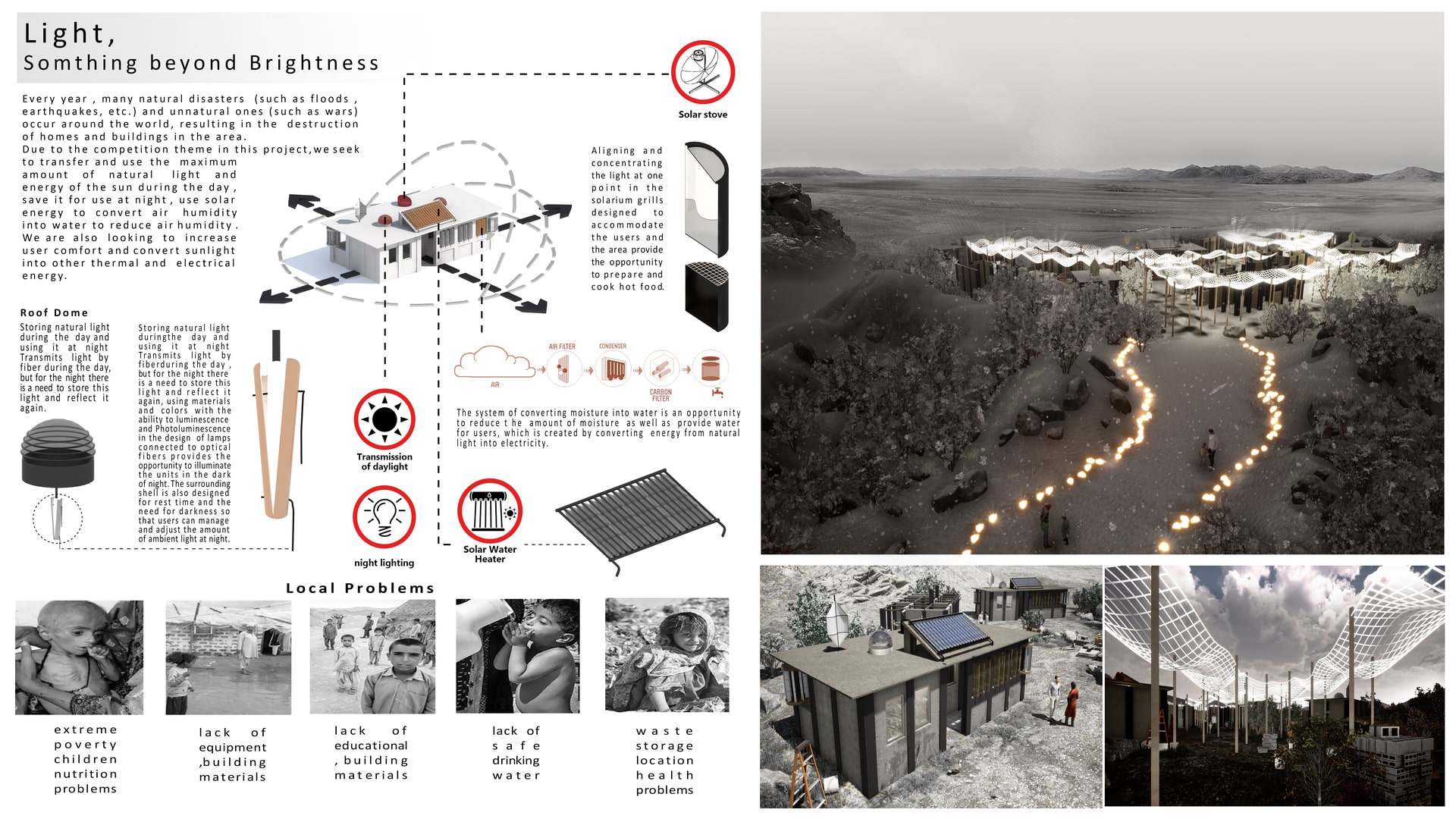Project Description
Every year, many natural disasters (such as floods, earthquakes, etc.) and unnatural ones (such as wars) occur around the world, resulting in the destruction of homes and buildings in the area. This makes post-accident housing very important. After the accident, there are many challenges due to power and water outages that could be more dangerous than the accident. Such as health problems, problems due to lack of shelter, lack of energy and lighting, reduction of security resulting from any traffic, theft, rape, psychological issues and demoralization and such cases, each of which causes financial and human losses. Due to the competition theme in this project, we seek to transfer and use the maximum amount of natural light and energy of the sun during the day, save it for use at night, use solar energy to convert air humidity into water to reduce air humidity. We are also looking to increase user comfort and convert sunlight into other thermal and electrical energy. With the help of these items, in addition to shelter, we can create a suitable housing for human activities and needs. Light, Something beyond brightness In addition to lighting, natural light has other potentials that, using design science, should be used to make users more comfortable. Sunlight is the basis of many active and passive systems of clean energy and sustainable architecture. Lighting and transmission of natural light to units Humans need ambient light to perform their activities, and the transmission of natural light into the building is very important. Optical fiber has the ability to receive and transmit light from one side to the other. The use of fiber optics on the ceiling and walls of the design provides an opportunity to transfer light into the building and provide a bright space for users. save natural daylight and use it at night The transmission of light by optical fiber during the day brings light into the space, but for the night it is necessary to store this light and reflect it again. The use of materials and colors with the ability of luminescence and photoluminescence in the design of lamps connected to optical fibers provides the opportunity to illuminate the units in the dark of night. The shell around it is also designed for rest time and the need for darkness. With this feature, users can manage and adjust the amount of ambient light at night. Hygiene and antimicrobial properties by sunlight Health is one of the most important things in people's lives. After the accident, many diseases will occur due to the problems that result from it. For this reason, the design of the space for placing clothes, fabrics and utensils and cleaning them with sunlight is considered in the plan to reduce diseases and its problems. Recycled solar water heater Man's need for hot water for washing dishes and utensils, hygiene items and bathing is undeniable. The design and construction of solar water heaters in units is one of the systems related to natural light in this project. Preparation and cooking of food by Solar Grill Natural light is the main source of global thermal energy. Transferring, aligning, and concentrating at one point in the solarium The grills designed to accommodate the users and the area provide the opportunity to prepare and cook hot food. Water is vital Due to the high humidity of Sistan and Baluchestan region and the special climate of this region, paying attention to ventilation and reducing humidity are some of the factors that increase the comfort of users. Moisture-to-water conversion system is an opportunity for users to reduce the amount of moisture and provide water consumption, which is created by converting energy from natural light into electricity. Light, brightness, security and a sense of security According to the principles of Crime prevention through environmental design (CPTED) Environmental lighting is one of the most important factors in reducing crime. The brighter the space, the more secure it will be. Humans also feel more secure in well-lit areas. Crime-related activities increase after each accident. The use of natural light, its storage by color and materials with the property of luminescence in the area in the form of stones indicating the path on the ground and the nets used on the top of the yard illuminates the space of the complex at night. Life, legibility and nightlife relief It is necessary to specify the route for sending troops and relief supplies. Due to the loss of infrastructure and power outages, rescue operations are usually difficult at night and are not performed. Designing the area and communication routes by storing daylight and reflecting it at night provides relief opportunities for relief workers.
